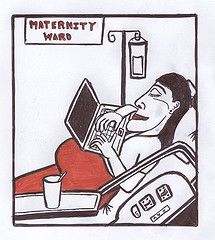The Ottawa Citizen recently explored the portrayal of fathers on the small screen, unpacking the common perception that TV dads are increasingly shown as inept, lazy, or immature. Think Ward Cleaver as compared to Tim Taylor, Ray Barone, or Homer Simpson. Diana Miller, a sociology graduate student at the University of Toronto, designed a study to compare fatherhood in 1950’s sitcoms to more recent shows like Two and a Half Men and Everybody Loves Raymond. She found, actually, more similarities than differences:
There is almost no difference in how often men express anger or emotional attachment. And men in the 1950s were almost as likely to say they were being victimized by someone else, such as their boss, as they do in the recent sitcoms.
Men in both sets of sitcoms also show almost equal amounts of self-deprecating behaviour. In Make Room for Daddy, Danny Thomas made affable comments about his mechanical ineptitude. Fast-forward 35 years and Chandler Bing of Friends was often revealed as deeply insecure. It’s a different kind of self-deprecation, but there’s not much difference in the number of these incidents on television, says Miller.
Probably the greatest difference Miller noted is that men in the recent sitcoms make fewer imperative statements, are less likely to be respectful to others, and less likely to be respected by others. It might signal a decline in male authority, but it’s also a sign of all-around lower standards of decorum and politeness, she says.
Men in the recent sitcoms are also more likely to be immature. In Miller’s recent sample, there were about five times as many incidents of immaturity as in the 1950s series. But sitcom women have also become increasingly immature.
“The shows that tell our stories have changed less than we acknowledge,” says Miller. “Men are getting more immature. But women are as well.”
Sitcoms do often rely on the bumbling or childlike man to produce some comedy value, but commitment and love for their families seems to be a mainstay. Old school gender roles are in TV-land flux, as men are often seen as taking on responsibilities in the household (though they also often try to shirk these tasks), and women are picking up the roles of disciplinarian and decision maker. Despite this, 1950s-style values still seem to permeate these make-believe families. Historian Judy Kutulas comments:
No matter how non-traditional families appear to be on the surface, they are still traditional to the core, says Kutulas, who points out that Modern Family has been cited as a favourite both with U.S. President Barack Obama’s family and Republican presidential contender Mitt Romney.
The show’s three families might be unconventional, but the husbands are breadwinners and their significant others are stay-at-home caregivers; this holds true even for the gay couple with an adopted daughter. The characters live in relative affluence and everyone has time for family gatherings.









